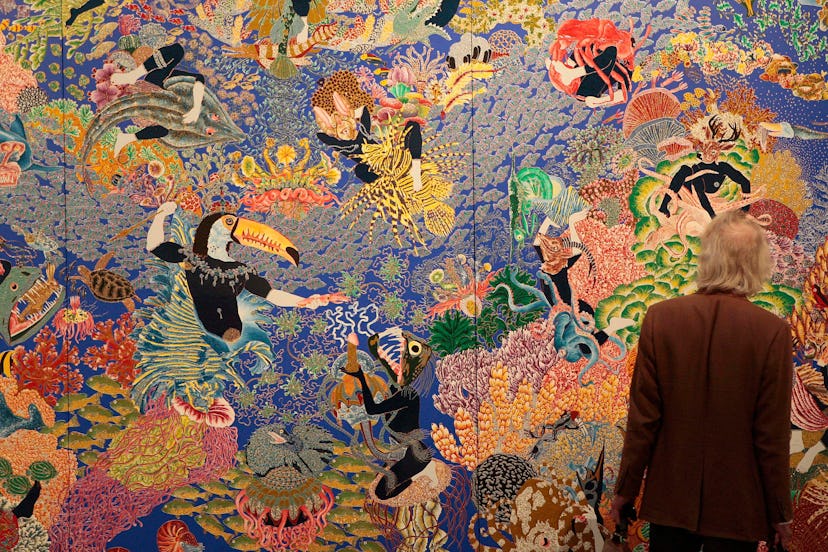Raqib Shaw Adapts His Striking, Shocking, Spectacular “Visual Symphony” for Dior

Observing a Raqib Shaw painting for the first time is akin to something borderline hallucinatory, like wading from bedroom consciousness to a sugary dream to a skin-crawling nightmare. Throughout, you do not quite know what’s imagined or what’s real.
Shaw’s works often depict a phantasmagoria of fauna in rapture—whether fornicating, hybridizing, or tearing one another’s guts out.
He takes the fundamentality of, say, an artist like Hieronymus Bosch and shellacks it in glitter and acrylic and highest-gloss kaleidoscopic shine. He goes, full speed, for familiar and falsified animals in hyper-sexualized and hedonistic presentations, bloodied with violence and anthropomorphized in behavior.
Courtesy of Dior and Raqib Shaw.
If his style sounds appealing—and it very much is, as it provides for nearly endless discovery and provocation—those interested can now purchase a Raqib Shaw work as a wearable accessory, via Dior’s Lady Art bag program.
Now in its fourth edition—having premiered at Art Basel Miami in December 2019 (with worldwide rollouts of the product continuing through January 2020)—Dior Lady Art’s initiative asks artists to create custom versions of the house’s classic Lady Dior bag. Shaw is one of eleven, this time around.
Here, the Kashmir, India-born artist sounds off on everything from his particular purse, to “maintaining agitation” when he creates (with a porcupine quill), to the fact that, ultimately, his work is not fashionable.
Art and fashion seem to be increasingly enmeshed. Would you agree or disagree?
I would agree. However, I would go so far as to say this has always been the case, only that in more recent times, fashion’s appetite has become ever more voracious.
How do you think your work best translates to a fashion object?
What parts of your work are, in essence, fashionable?
Translation in and of itself is a work of art. It is a question of what happens when one language (in my case, painting) passes into another (fashion). The translation becomes a form of its own. Which is why, when I collaborate as I have done with Dior, it becomes a matter of trust. They understood my technique and aesthetic, which was to re-create the initial sensory experience when one encounters my work. Then, the eye and mind settle down, each painting reveals itself as a carefully constructed visual symphony where all elements are interconnected, taking the viewer on a visual and psychological journey. As for my work being fashionable, then I would say it isn’t.
Courtesy of Dior and Raqib Shaw.
What were the unique challenges with creating a bag for Dior, specifically?
When Dior approached me with this project I was in the midst of making work for an exhibition in New York. No matter how organized one is, preparing for an exhibition is always a crazy time! It was from within this maelstrom that the designs for the Dior bags took shape. I realized quite quickly that I didn’t want to try and reinterpret the Lady Dior bag—rather, I was interested in seeing how the motifs in my own paintings could be replicated, reinterpreted, even. I drew inspiration for the designs from a number of my paintings, for example, magnolia trees and charms. I wanted the bags to be a true reflection of my paintings, and so my designs were created in the exact same manner. I started the process by producing a series of drawings which were then transferred to a painting surface using an old-fashioned overhead projector. When complete, the surface is laid flat and the composition is outlined with a gold acrylic liner, a technique very similar to “cloisonné.” Once dry, the acrylic liner forms a sort of dam, and the paints are then poured in. The paint cannot escape because it is within the confines of the gold liner, it is within these tiny dams that the paints are manipulated with a porcupine quill, the idea being that, in blending and mixing the colors, you take advantage of the agitation between the materials. It’s about maintaining the agitation so that you actually use it to your absolute benefit.
Courtesy of Dior and Raqib Shaw.
How did the past year inform your creative sensibility?
A few months ago, I had a solo exhibition called Landscapes at Pace New York. It was a first for me. I drew inspiration from my childhood memories of Kashmir and the nature and architecture of the Indian subcontinent. It was an attempt at re-envisioning my own personal history through painting. I have always been driven by aesthetics and my interest in horticulture plays a significant part in this. Historically, Kashmir was embraced as heaven on earth by the Mughal Emperors, and some of the greatest gardens of that period, exist there. That, coupled with my love of the landscape architect Lancelot Capability Brown and the setting of eighteenth century English Literature, are my main inspirations. It all feeds into my work and artistic expression and allows me to survive the harsh realities of life!
Courtesy of Dior and Raqib Shaw.